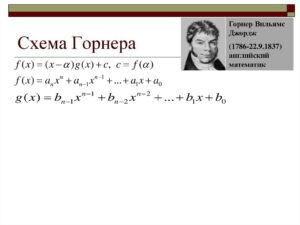SHARE WITH FRIENDS:
The root of the polynomial. Bezu's theorem. Horner scheme
Plan:
-
The root of the polynomial
-
Bezu's theorem
-
Horner scheme
f(x)=anxn+an-1xn-1+...+a2x2+a1x+a0 be given a lot.
Description. If the value of the polynomial f(x) becomes zero at a value a of the variable x, this number a is called a root of the polynomial f(x).
To determine the roots of the polynomial f(x), it is necessary to solve it equal to zero. The roots of this equation are also the roots of the polynomial f(x).
Example 1 f(x)=x4-13x2Find the roots of the polynomial +36.
Solving. x4-13x2+36 x4-4x2 -9x2+36=0 (x2-4)(x2-9)=0. This equation breaks down into two equations:
1)x2-4=0 (x-2)(x+2)=0
2)x2-9=0 (x-3)(x+3)=0
The roots of the given polynomial are: -3;-2;2;3.
Example 2. f(x)=2x5+x4-10x3-5x2Find the roots of the polynomial +8x+4=0.
Solving. 2x5+x4-10x3-5x2We solve the equation +8x+4=0.
2x5-4x4+ 5x4-10x3-5x2+10x-2x+4=0
2x4(x-2)+5x3(x-2)-5x(x-2)-2(x-2)=0
(x-2)(2x4+ 5x3-5x-2)=0
(x-2)[2x4+ 2x3+ 3x3+ 3x2-3x2-3x-2x-2]=0
(x-2)(x+1)(2x3+ 3x2-3x-2]=0
(x-2)(x+1)(x-1)(2x2+5x+2)=0
(x-2)(x+1)(x-1)(2x+1)(x+2)=0
x1=-0,5; x2=-2 ;x3=-1; x4= 2.
Thus, the roots of the given polynomial are -0,5; -2;-1; 2 will be.
Bezu's theorem. f(x)=anxn+an-1xn-1+...+a2x2+a1x+a0 (a0) the remainder from dividing the polynomial x into two terms is equal to the value of the polynomial when x=a:
r = f(a) =
The result. A number a is a root of f(x) if and only if the polynomial f(x) is divisible by x.
An example. f(x)= x3-1 is divisible by the polynomial x=1. Since x=1 the number f(x)= x3-1 is the root of the polynomial, that is, f(1)=0
Finding the roots of a polynomial f(x) is as powerful as finding its linear divisors in the form x.
Examples:
1)x2-a2 the double is divisible by both xa and x+a;
2)x2+a2 the pair is not divisible by xa or x+a;
3) x3-a3 ikihad ikihad is not divisible by xa or x+a;
Horner scheme. fx)=anxn+an-1xn-1+...+a2x2+a1x+a0 we show the so-called Horner (William Horner (1786-1837) - English mathematician) scheme for calculating the remainder of the x-binomial division of the polynomial.
Let f(x)=q(x)(xa)+r (1).
Here q(x)= b0xn-1+b1xn-2+b2xn-3+...+bn-1.
Equating the coefficients in front of the same levels of x in (1), we get:
a0=b0
a1=b1-b0
a2=b2-b1
...
an-1=bn-1-bn-2
an=r — bn-1
it appears that b0=a0, pk=bn-1 +ak, k=1,2,3,..., n-1, r=-bn-1.
The calculation of the quotient and remainder is found using the table below.
a0 |
a1 |
an-2 |
... |
an-1 |
an |
|
b0+a1 |
b1+a2 |
... |
bn-2+an-1 |
bn-1+an |
||
b0= A0 |
b1 |
b2 |
bn-1 |
r |
This scheme is called the Gorner scheme.
Example 1. x3+ 4x2Divide the polynomial -3x+5 by x-1 using the Gorner scheme.
1 |
4 |
-3 |
5 |
|
1 |
1 |
5 |
2 |
7 |
So, x3+ 4x2-3x+5=(x-1)(x2+5x+2)+7.
It follows from Bezou's theorem that the remainder r, which is formed by dividing the polynomial f(x) into a binomial of the form ax+b, is equal to f.
Example 2. P(x)= x3-3x2Find the remainder of dividing +5x+7 by 2x+1.
Solving. The remainder is r=P.
Example 3. P4(x) = x4+x3+ 3x2Find the remainder of dividing the polynomial +2x+2 by x-1
According to Bezu's theorem:
P4(1) = 1+1+3+2+2 = 9
Example 4: P2(x) = x3+ 2x2+ yes2 If the remainder of dividing the polynomial by x-2 is 8, find ani.
P2(2) = 23+42+2-a2= 8
a2= 10
a= —
a=
Answer: a=
Example 5: P5(x)= 2x5 –X4-3x3Find the remainder of dividing +x-3 by x-3.
P5(x) = (x-3) (2x4+ 5x3+ 12x2+36x+109) + 324
2 |
-1 |
-3 |
0 |
1 |
-3 |
|
3∙2 |
3∙5 |
3∙12 |
3∙36 |
3∙109 |
||
C = 3 |
2 |
5 |
12 |
36 |
109 |
324 |
Theorem. If a number P(x) is a root of a polynomial, then P(x) is divisible by the polynomial x- without remainder.
Basic phrases: polynomial, root, Bezu, Gorner
Control questions:
-
Dividing a polynomial as a remainder
-
Bezu's theorem
-
Horner scheme
Assignments
Example 1. F(x)=2x5+x4-10x3-5x2Find the roots of the polynomial +8x+4.
Example 2. F(x)=x4-13x2Find the roots of the polynomial +36.
Example 3. Using the Gorner scheme, find the value of the polynomial f(x) at the point x=a.
1) f(x)=; 2) f(x)=; 3) f(x)=
Control questions:
Reduce fractions:
-
miso l.
simplify the expression.
Y solves h. We simplify the given expression according to the steps of action and the rules for their execution:
5-miso l. simplify the expression.
Y solves h. a > 0 when a-r Using the relation = (0 < r ê Q), we simplify the given expression:
1) 1 + — +
References:
-
"Fundamentals of Algebra and Analysis" RH Vafoyev. 349 pages,
-
A. Abduhamidov "A collection of problems from the basics of algebra and mathematical analysis" pages 48-52.
-
A. Abduhamidov "Fundamentals of Algebra and Mathematical Analysis"
-
A. Melikulov "Mathematics" Part I, pages 89-93
P3(x) = x3-3x2Find the remainder of dividing +5x +7 by 2x+1.
Does the polynomial P(x) divide the polynomial D(x).
-
a) P(x) = x100 –3x+2 D(x) = x-1
-
b) P(x) = x100 –3x+2 D(x) = x+1
-
c) P(x) = x100 –3x+2 D(x) = x2-1
